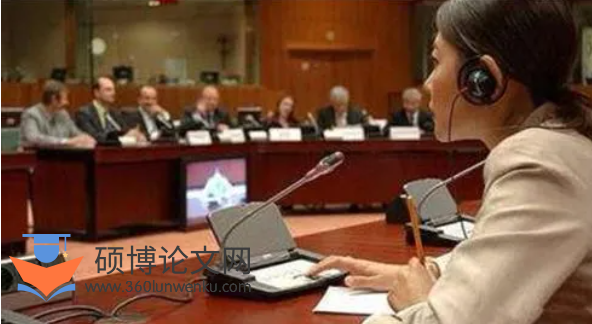本文是一篇英语论文,本文将进一步提出译员在电视同传中的语言、非语言应对策略。具体而言,语言策略主要包括合理预测助听析、顺句驱动减记忆、精简增补优产出和灵活调整促协调四方面;非语言策略主要包括加强译前准备、增加语言外知识、提升电视同传技巧和提高抗压能力。
Chapter One Introduction
1.1Research background
Simultaneous interpreting, as a very challenging form of interpretation, has always been a focus of interpretation research. Against the backdrop of increasingly interconnected globe and fast-changing sci-tech innovations, with the surging demand of the public to receive fresh information in the first place, simultaneous interpreting, thanks to the popularization of mass media, has witnessed a widespread dissemination in television and also grabbed broad attention among people all over the world. Due to the immediacy, flexibility as well as high-efficiency of simultaneous interpreting, coupled with the benefits of breaking through time limits and collapsing language barriers, TV simultaneous interpreting has come into being and played an increasingly vital role in facilitating global communications exchanges.
Meanwhile, as the flourishing of TV simultaneous interpreting, it is self-evident that it has brought about an overwhelming number of problems for simultaneous interpreters to cope with in such high-demanding TV settings. Therefore, there is no doubt that TV simultaneous interpreting has posed a greater challenge to the effort allocation of simultaneous interpreters and thereby also to the overall performance of them.
To this end, it is very essential to analyze the cognitive load and coping strategies for TV simultaneous interpreter in this working setting. However, TV simultaneous interpreting namely TV SI, as an application and extension of simultaneous interpreting in TV media, has seen little systematic research in academia. This thesis, with Daniel Gile’s Effort Model as a main theoretical framework, is primarily focused on analyzing simultaneous interpreter’s cognitive load as well as the problem triggers in TV SI and therewith throwing out coping tactics on how to respond to these challenges so as to enhance performance.

英语论文参考
...............................
1.2 Significance of the study
TV SI, originated from the western world, is applied extensively, demonstrating a diverse development trend. It can be easily seen that the application of TV SI ranges from single news reporting at the outset to current various and enriched scenarios such as political addresses, entertainment and sports. As a new branch of simultaneous interpreting, TV SI is studied earlier abroad than at home and has seen its research far from rich.
Daniel Gile, a renowned French scholar in translation and interpretation, has put forward with the Effort Model which also named as Cognitive Load Model serving as a conceptual framework for simultaneous interpreting. However, when it comes to the research combining Gile’s Effort Model with TV SI and aiming to analyze the situation of simultaneous interpreter’s cognitive load, it’s still in its infancy. Even if there are individual studies analyzed TV simultaneous interpreter’s cognitive load and coping tactics with Gile’s Effort Model, what has been selected serving as the corpus is always related to political discourses or debates and hence is a little bit monotonous.
Therefore, this thesis will not only be able to broaden the application scope of Gile’s Effort Model by applying this model and Tightrope Hypothesis in TV SI but also can be helpful for the further study of TV SI, thus containing far-reaching academic value. In the meantime, besides theoretical significance, the author of this thesis also reckons that it also has considerable reference value and can provide some guidance for future practices of TV SI. Through this study, the author intends to help simultaneous interpreters better allocate their cognitive efforts by using effective coping strategies and ultimately motivate them to improve their professional level and provide better service in TV SI.
..............................
Chapter Two Literature Review
2.1 Introduction of TV SI
To begin with, before further discussions on TV SI, it is of great importance to specify what exactly TV SI is. Based on that, how it has developed and what are the characteristics of TV SI are also crucial questions which need to be answered and sorted out. In this section, this thesis will sketch the definition, development and features of TV SI step by step so as to give a glimpse of this special domain of interpreting in the media.
2.1.1 Definition of TV SI
It’s fair to say that one can get the definition of TV SI by putting it in the general picture of media interpreting on account of its sub-domain feature.
According to Pöchhacker, media interpreting usually refers to broadcast mass media, like radio and television. As the internet platform develops at a fast track, he also notes that newer types of electronic media and transmission such as webcasting also need to be taken into account (2007, pp. 124). Wu Yuanning puts that TV simultaneous interpreting is a form of media interpreting by combining one TV, one kind of media, with simultaneous interpreting, one form of interpreting (2015, pp. 99). As Yang Chengshu insightfully remarks, TV SI is useful and indispensable when information goes to foreign language and need to be conveyed rapidly and instantly. On account of conveying the information under the support of sound and images to foreign audience, people find that simultaneous interpreting plays an inevitable role in such TV background (2005, pp. 6).
...............................
2.2 Studies of TV SI both at home and abroad
TV SI, as an emerging field of research, has seen hardly any theoretical and systematic framework in academic circles. Nevertheless, there are still a lot of enviable results gained by academia.
Since TV SI first appeared in the west, western scholars have explored it in much more depth and they have been relatively more advanced in this area. While domestic research on TV SI has started late and is relatively less and not that mature.
2.2.1 Previous studies on TV SI abroad
Foreign scholars carried out the research on TV SI mainly from the aspect of challenges and stresses for interpreters as well as quality assessment standards in TV settings compared with those in conference settings.
Many foreign scholars have emphasized the high stress level and formidable challenges in TV SI.
Viaggio (2001) expresses the most salient features of simultaneous interpreting for the media (SMI) at the communicative, translational, neurophysiological, pedagogical, social and other levels. He reckons that media interpreter must have capability to tackle any subject, any dialect, and any speaker at any time and must be equipped with overarching knowledge of the communicator, journalist, and interpreter.
..............................
Chapter Three Theoretical Framework .......................... 16
3.1 Gile’s Effort Model ........................................ 16
3.2 The Tightrope Hypothesis .................................... 17
3.3 Four major efforts of the Effort Model in SI .................................... 17
Chapter Four Problem Triggers and Coping Tactics in TV SI under Gile’s Model ............................. 22
4.1 Problem triggers in TV SI based on the Effort Model ............................... 23
4.1.1 Problem triggers on listening and analysis ............................ 23
4.1.2 Problem triggers on short-term memory .................................. 27
Chapter Five Conclusion ..................................... 52
5.1 Findings of the research ........................................ 52
5.2 Limitations of the research .............................. 54
5.3 Suggestions for future research ........................... 55
Chapter Four Problem Triggers and Coping Tactics in TV SI under Gile’s Model
4.1 Problem triggers in TV SI based on the Effort Model
TV SI, due to its uncertain and unpredictable nature, often makes interpreters hard to prepare in advance so that will pose a lot of challenges for interpreters. In this section, problem triggers in TV SI will be analyzed based on Gile’s Effort Model from four perspectives including listening and analysis, short-term memory, speech production and coordination through specific examples. 4.1.1 Problem triggers on listening and analysis
It is generally accepted that listening and analysis is prioritized as a cornerstone in simultaneous interpreting. Without a qualified capability of listening and analysis, interpreters would be unable to embark a smooth journey on delivering what speakers want to convey. If interpreters can do a well-done job in listening and analysis, the first step or the prerequisite of interpreting, they will save more energy for other efforts such as speech production and short-term memory. With this regard, they will be handy with facility in dealing with more complex tasks to a large extent.
In TV SI, the working environment is more complicated than regular meetings. It may include voices on all sides especially for simultaneous interpreting in on-site news report in which interpreters cannot sit in the booth. Under this circumstance, it will cause more challenges to listening and analysis owing to the noises from the surroundings, so that interpreters are supposed to be more capable to concentrate in listening and analysis. As Gile has noticed, the Listening and Analysis Effort is not an automatic process (2011, pp. 149). Hence, interpreters must increase their capabilities in this respect so as to reduce problems such us misinterpreting and omissions.

英语论文怎么写
...............................
Chapter Five Conclusion
5.1 Findings of the research
To begin with, this thesis analyzed the problem triggers of interpreter’s cognitive load as well as coping strategies for TV SI with Daniel Gile’s Effort Model as its core framework. After detailed analysis with concrete examples, this thesis has found that in terms of listening and analysis, the reasons for the cognitive load of interpreters are mainly due to factors such as high density of the source speech involving high density of information and high rate of delivery, as well as the speaker’s own expression habits; in terms of short-term memory, the main reasons for problems are dense numbers and names which aroused signal vulnerability; In terms of speech production, it is mainly because that syntactic differences between the source language and the target language have taken up interpreter’s memory and energy, resulting in pauses in output, lack of fluency, and even omission or other improper delivery; in terms of coordination, it is mainly due to the Effort L, P and M which have occupied too much energy from the interpreter and causes the interpreter to have an overload coordination.
It is also perceived by this thesis that the four cognitive efforts including the Effort L, P, M and C are not totally separated from each other while instead. They are closely intertwined. It’s fair to say that the allocation among these four efforts in TV SI will be able to set off a domino effect. Such kind of balance is dynamic with the four efforts hooked up with each other. Hence, it can also be safely concluded that problem triggers in TV SI can be boiled down to not merely one single effort, although this thesis has discussed them based on these four efforts respectively. For example, the high-dense speech will not only affect the Effort L by consuming the energy for listening and analysis, but also the Effort M by increasing the memorial processing burden, hence the Effort C.
reference(omitted)
